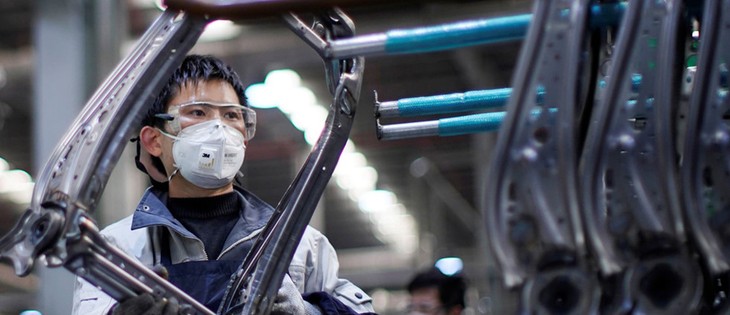(VOVWORLD) - Since the end of March, Chinese factories have been quickly resuming production. Employees are returning to work and production lines are beginning to operate. But the Chinese economy has been slow to respond because the global supply chain has been interrupted by the lockdown and isolation measures many countries have applied to contain the rapidly spreading COVID-19 epidemic.

An employee works at a car seat factory in Shanghai (Photo: Reuters)
|
A representative of China's Ministry of Industry and Information Technology announced Monday that more than 98% of China’s large industrial companies have resumed production, and 90% of workers are already back at work. At major industrial centers like Guangdong, Jiangsu, Zhejiang, Shandong, and Fujian, production capacity is at almost the same level as before the outbreak. Shopping centers in Wuhan, the capital of Hubei and the original COVID-19 epicenter, reopened early this week.
Heavy blow to the economy
Breaking out in late December last year in Wuhan, the COVID-19 epidemic swept quickly throughout China, taking a huge toll on the economy. When the disease showed signs of having peaked and gotten under control in China, the Chinese hurried to resume production. But on Tuesday, the World Bank projected China's growth might come to a standstill because of the pandemic.
Chinese companies are being more flexible now in hiring workers. Some companies have sought permission to use vans, buses – even hired airplanes – to bring their workforce back from remote areas. Other firms have begun to use automation to compensate for labor shortages, and some are using cutting-edge technology to train new hires. Car sales in China are slowly recovering as consumers start to buy again. Chinese airlines are gradually resuming their flight schedules.
Relaxed monetary and financial policies are in place to stimulate the economy. Companies affected by quarantine measures and declining business operations have been given credit extensions until June. China has lowered bank reserve requirements to enable banks to provide more loans to small and medium-sized enterprises. The government has allowed businesses affected by the pandemic to be temporarily exempt from paying electricity bills. At the same time, the government is considering increasing the budget deficit and issuing special treasury bonds.
Logistics chains interrupted
Efforts to restore domestic production will not be enough to revive the Chinese economy. Chinese factories that are back at their maximum capacity can do nothing about the many orders from foreign customers that have been canceled or delayed because of lockdowns. A sharp reduction in export growth is unavoidable. Although the domestic economy is slowly recovering and business confidence is gaining momentum, international organizations have lowered China's growth forecast for this year.
China will most likely see negative GDP growth in the first quarter of this year, something that has not been seen in decades. The Chinese economy in 2020 will be its weakest in 44 years. Since the COVID-19 pandemic has not yet peaked globally, economists say the worst has yet to happen to China's exports and supply chains.